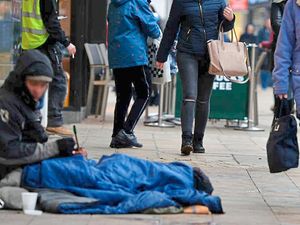When did it become ok to walk past the needy?
Express & Star columnist Louise Rouvray asks whether enough is being done to help the homeless

While walking past Selfridges at the weekend, with its famed aluminium discs glinting in the sun and customers armed with bright yellow bags emerging from glass double doors, I noticed a man sat by the entrance that everyone seemed to be ignoring. The reason why? He was homeless.
Shoppers quickly scuttled past him, clutching their purchases close to their chests, some purposely crossed the road to avoid being asked for some spare change while others simply scowled and shook their heads.
The problem is many people think the same thing – give a homeless person money and they’ll spend it on drink and drugs. The rising number of ‘professional’ beggars who pretend to be destitute doesn’t help either.
There also seems to be a very ‘it’s not my problem’ attitude adopted by many. But as summer draws to a close and the cold approaches, we can’t turn a blind eye to the tatty clothes and worn faces filling the streets.
Many people sleeping on the streets are in desperate need of medical and psychiatric help. But instead they are sat on a freezing cold pavement, often using booze and drugs as a way to stay warm and avoid reality, living out in the open, scrutinised, judged, their problems ignored.
Luckily, mental health issues are becoming a more mainstream talking point and the Government is recognising the need to put more funding into this sector. But it’s not enough.

Walking through Wolverhampton, Birmingham and our town centres, seeing men and women wrapped up in newspapers and sleeping bags has become a norm. This is quite simply wrong, especially when multi-billion pound developments are springing up and thousands is being invested in shopping centres. Why isn’t money being poured into shelters and sanctuaries?
Instead many are left to put on fundraising events just to stay open and rely on the goodwill of volunteers.
Psychiatric care in Britain took a wrong turn when the ‘care in the community’ approach was adopted and aimed to ‘normalise’ the mentally ill and remove the stigma that came with many conditions.
By the 80s and 90s swathes of mental hospitals had shut down, as patients moved into an open society, no longer locked away behind closed doors.
Mental hospitals and asylums were not perfect, but there were free beds, free treatment and free food for people with mental illness who had no homes. While they are no longer institutionalised, now they are simply ignored – which is worse?
Many are ending up in prisons, not hospitals, and the only way for people to be sectioned is if they cause or threaten harm to themselves or others. What backwards world do we live in where a person has to turn on another human or themselves before someone steps in to help?
The perception of the mentally ill may be changing, with more tolerance and acceptance, but cities and towns are still seriously lacking in resources and services.
There also needs to be more awareness of where help is available – if you were asked to direct a rough sleeper to the nearest shelter, would you know the answer?
Instead of flyers filled with adverts and promoting tourist attractions, leaflets should be available at train and bus stations mapping out the nearest refuge centres and listing help lines.
Sadly the majority of shelters operate on a ‘first come, first serve’ basis, have strict rules and schedules and are overcrowded – but this needs to change. Our towns and cities need more beds for the vulnerable.
Housing homeless and treating the mentally ill should be a top priority, especially as the ticking timebomb of winter looms.





